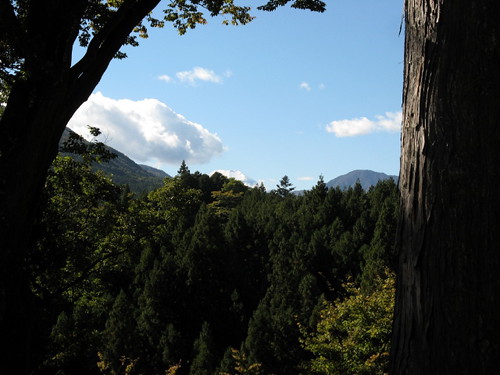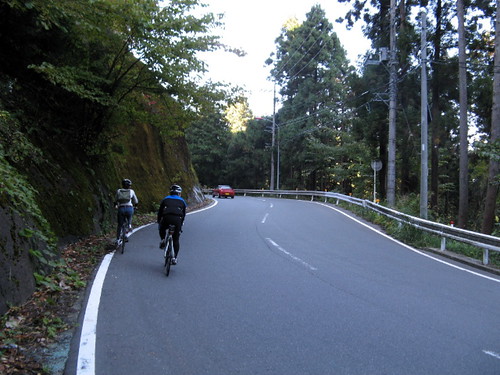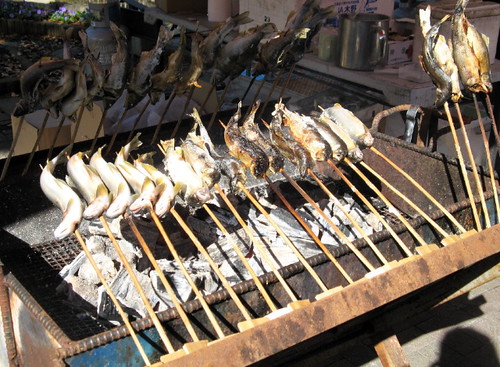But That’s Midnight to You
- By Kevin Boyce
- November 12, 2010
- 2 Comments
It’s 1 PM, and I’m sampling the local cuisine, 7000 miles from home and 50 km from my second home outside Tokyo, hoping I can make it back before dark on my rented bicycle. Hi everybody, I’m new to Blueshift, but not new to Japan. I’ve been coming over to the Institute for Space and Astronautical Science (ISAS) since the late 90’s, working first on the Astro-E mission, then Astro-E2 and now Astro-H. These are all X-ray astronomy satellites, and they all make use of a microcalorimeter spectrometer built at Goddard.
Use of a s-what? A spectrometer, which measures the spectrum of incoming light (or in this case, X-rays). That is, it measures the energy of each X-ray photon it sees. For X-ray astrophysicists, the most important information is in the spectrum. Sadly, the usual methods of measuring a detailed X-ray spectrum are inefficient, so you have to expose the sensor for days to get a useful signal. What you wish you could do is catch all the photons and accurately measure each one. That’s where the microcalorimeter part comes in. You might have used a calorimeter in chemistry class to measure the heat of a reaction. Our microcalorimeters work the same way, only they measure the heat of a single photon. The higher the energy of the photon, the more heat.
So we built a sensor with 32 microcalorimeters and put it on the Japanese Astro-E mission, which launched in 2000. Unfortunately, the rocket didn’t reach orbit due to a failure in the nozzle. So in 2005 we tried again with the Astro-E2 mission. That one got to orbit and was renamed Suzaku, in ISAS tradition. The microcalorimeter instrument worked great for a couple weeks. But then, due to an oversight in the design, it lost all its liquid helium and stopped working. (The other instruments on the spacecraft are still going strong.)
ISAS (now part of JAXA, the Japanese Aerospace eXploration Agency) is now preparing the Astro-H mission, and we’re working with them once again. The details are slightly different this time, and there are more instruments on the spacecraft, but the microcalorimeter technology is the same.
Many of the people are the same too, on both sides of the Pacific. We’re not all old friends here, though it seems like it. But that’s not why we meet so much more this time. The failure of the microcalorimeter on Suzaku was due to incomplete communication, and none of us is interested in doing that again! So we’re meeting 5-8 times a year in the planning stage (compared to once or twice a year on the previous missions). We build up a lot of frequent flier miles, but it’s worth it.
And so, on this beautiful Wednesday, a Japanese holiday with no meetings in the middle of a week of travel, we find ourselves in Tokyo with no obligations. As it happens, one of our Japanese colleagues is an avid cyclist, who regularly rides 150 km up into the mountains. He and four grad students are riding today, and he’s rented me a bike so I can join them. The downsides are that the rented bike is small for me (like most everything in Japan), I’ve managed to do almost no training for the ride, and our destination is 700 meters up as well as 50 km distant. The upside is that it’s down all the way back. (Well, almost.)
As we climb into the mountains, it begins to look like rural Japan. To me at least, rural Japan is twisty narrow roads clinging precariously to slopes steep enough to warm the heart of a snow leopard. Not ideal for driving, but great fun on two wheels. We are passed by many people on cycles, most with 1000cc motors, but many of them human-powered. About 10 km from our destination (the small village of Doushi) is a small pull-off zone with the first view of Mt. Fuji.

Mt. Fuji peers over the local hills. No, the photo does not do it justice. Nor does it capture the beauty of the cypress forest, which puts me in mind of Miyazaki’s Princess Mononoke. Note that the mountain is trying to make its own clouds. It was far more successful in that venture when we tried to climb it in 2003.
Finally we reach Doushi, which I’m sure is more than a roadside stop, but that’s the part we see. Hundreds of people have stopped here, many on bikes or motorcycles, to rest and sample the local fare. There is pork on a stick, pork soup, and fish on a stick as the featured attractions. Very fatty pork, but Tsujimoto-san’s bike computer says we’ve burned 1300 calories getting here, and it’s all delicious.
We take a leisurely lunch and head back. It took four hours to get there, it takes less than three to get back. The few uphill sections on the way back are a bit of a heartbreak, but we all make it. The others are graduate students, still young and energetic. This old man was glad to have made the trip at all. The next two days will be spent sitting in a small chair in a large meeting room not moving, so the exercise was a great thing.
And it was an excellent trip from an engineering standpoint too. We resolved dozens of open issues, and return the the U.S. with the usual renewed understanding of how important face-to-face meetings are. We have videoconferencing technology, and we use that too, but some things that take hours or days by email or videocon can be worked out in minutes when we’re all in the same room. So the 22 hour trip (each direction) and the jet lag are worth it. The Astro-H Soft X-ray Spectrometer is going to be the instrument astrophysicists have been waiting for for 14 years.





It’s funny that you always hear about how crowded it is in Japan and most of the images and videos from the main stream media are focused on the cities but the photos from your bike ride show a much different picture of Japan. In fact if I didn’t know it was Japan I would have guessed it was somewhere in Washington or Oregon.
Fascinating article, Kevin. Astrophysics, Japan and cycling. What a killer combination. Great to see some of Japan that goes beyond the busy techno city stereotype. I would imagine that, due to the vagaries of the weather, that you’d have to do some indoor cycle training too. Totally agree with you about the benefit of face-to-face decision-making. The virtual world has its virtues but nothing beats having a meeting in the same room. Looking forward to hearing more about the Astro-H Soft X-ray Spectrometer. Go well.